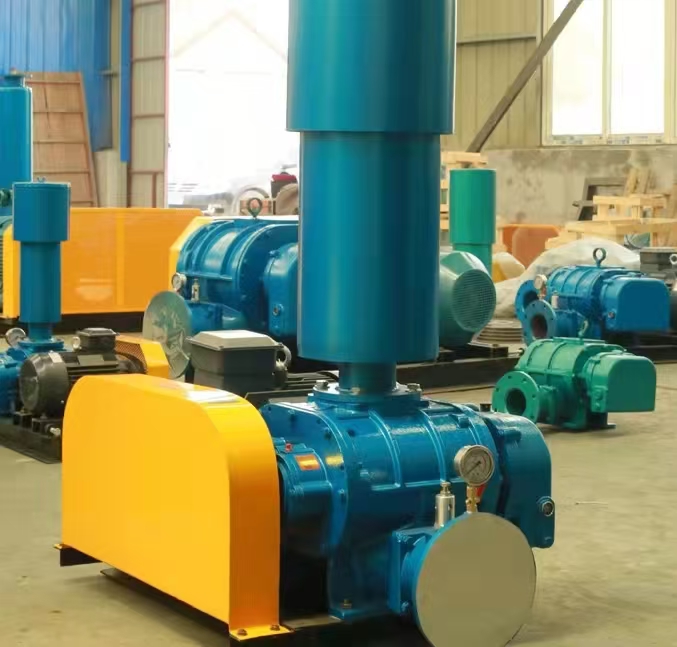The selection of Roots blower requires comprehensive consideration of multiple factors such as flow rate, pressure, medium characteristics, and operating environment to ensure stable operation of the equipment. The following are detailed selection steps and key parameter explanations:
---

**1. Selection of core parameters**
**(1) Flow rate (air volume, Q)**
-* * Unit * *: usually * m3/min * * or * * m3/h * *.
-* * Calculation method * *:
-Determine the required air volume based on process requirements (such as sewage treatment aeration rate, pneumatic conveying material volume, etc.).
-Consider * * system leakage rate * * (usually increasing by * * 5-10 * * margin).
-* * Example * *:
-The aeration requirement for sewage treatment is 10m3/min, and a fan with a capacity of 11m3/min can be selected for selection.
**(2) Pressure (wind pressure, P)**
-* * Unit * *: usually * * kPa * *** Bar * * or * * MPa * * (1 bar ≈ 100 kPa ≈ 0.1 MPa).
-* * Calculation method * *:
-The * * outlet pressure of the fan * *=* system resistance * * (pressure loss of pipelines, valves, aeration heads, etc.)+* * liquid level pressure * * (such as sewage treatment water depth).
-The rated pressure of Roots blower should be slightly higher than the actual demand (generally 1.1-1.2 times).
-* * Example * *:
-If the sewage treatment water depth is * * 4m * * (≈ 40 kPa) and the pipeline resistance is * * 10 kPa * *, then the fan pressure needs to be ≥ * * 50 kPa * *.
**(3) Power (N)**
-* * Unit * *: kW (kilowatts).
-* * Estimation formula * *:
\[
N = \frac{Q \times P}{60 \times \eta}
\]
-(Q): Flow rate (m3/min)
-(P): Pressure (kPa)
-(eta): Fan efficiency (generally * * 0.6~0.8 * *, refer to manufacturer data for details).
-* * Example * *:
- \( Q = 10 \, \text{m3/min} \),\( P = 50 \, \text{kPa} \),\( \eta = 0.7 \)
-Calculation:\ ( N = \frac{10 \times 50}{60 \times 0.7} ≈ 11.9 \, \text{kW} \), Optional * * 15 kW * * motor (considering margin).
---
**2. Key factors for selection**
**(1) Medium characteristics**
-* * Ordinary air * *: Standard model (made of cast iron material).
-Corrosive gases (such as chlorine and hydrogen sulfide): require stainless steel or special coatings, rotors, and mechanical seals.
-Dust/particulate gas (such as cement transportation): Install an intake filter and choose wear-resistant rotor material (such as high chromium alloy).
-High temperature gas (>80 ℃): Water cooling or high-temperature resistant bearings/seals are required.
**(2) Speed (n)**
-* * Standard speed * *: Usually * * 1000~3000 rpm * *.
-* * Impact * *:
-Speed ↑ → flow rate ↑, but noise ↑, wear ↑.
-Speed ↓ → flow ↓, but longer lifespan.
-Adjustment method:
-Variable frequency control: Adjust the flow rate by adjusting the motor speed (energy-saving, recommended).
-Belt pulley adjustment: Mechanical speed regulation (suitable for fixed working conditions).
**(3) Noise requirements**
-* * Standard noise * *: 85-100 dB (A).
-* * Noise reduction measures * *:
-Choose a three bladed rotor with lower noise than a two bladed rotor.
-Install * * muffler * * or * * soundproof cover * *.
-Adopting * * variable frequency motor * * (to reduce high-speed operating noise).
**(4) Installation method**
-Direct connection type: The motor is directly connected to the fan, with a compact structure and high efficiency (suitable for high power).
-Belt drive: Adjustable speed, easy to maintain (suitable for low power or variable working conditions).
---
**3. Selection steps**
**Step 1: Determine the working condition requirements**
-Clearly define parameters such as flow rate (Q), pressure (P), medium, and ambient temperature.
**Step 2: Calculate power**
-Estimate the required motor power based on Q and P.
**Step 3: Select the sealing method**
|* * Operating conditions * * | * * Recommended sealing * *|
|----------|-------------|
|Ordinary air | Maze seal|
|Dust containing gas | Packing seal+labyrinth seal|
|Corrosive gas | Mechanical seal (double end face)|
|Flammable and explosive gases | Dry gas seal|
**Step 4: Select Material**
|* * Medium * * | * * Recommended Material * *|
|----------|-------------|
|Air/General Gas | Cast Iron|
|Corrosive gas | Stainless steel (304/316)|
|High temperature gas | heat-resistant alloy steel|
**Step 5: Select Additional Configuration**
-* * Muffler * *: reduces noise (optional).
-* * Inverter * *: Energy saving flow regulation (recommended).
-* * Filter * *: protects the fan (necessary for dusty conditions).
---
**4. Common selection errors**
**Error 1: Only select based on motor power**
→ It may lead to insufficient flow or pressure, and a comprehensive calculation should be made for both Q and P.
**Error 2: Ignoring the corrosiveness of the medium**
Ordinary cast iron fans used in chlorine environments will rapidly corrode and require stainless steel material.
**Error 3: Failure to consider system resistance**
The actual pressure should include pressure loss in pipelines and valves, otherwise the air volume will be insufficient.
---
**5. Typical Application Selection Example**
**Case 1: Aeration in sewage treatment**
-* * Requirement * *:
-Flow rate: 15 m3/min
-Water depth: 5 meters (≈ 50 kPa)
-Pipeline resistance: 10 kPa
-* * Total pressure requirement * *: 60 kPa
-* * Selection * *:
-Fan model: RRB-150 (flow rate 16 m3/min, pressure 80 kPa)
-Motor power: 22 kW (variable frequency control)
-Sealing: Maze seal (ordinary air)
-Material: Cast Iron
**Case 2: Pneumatic conveying of cement**
-* * Requirement * *:
-Flow rate: 8 m3/min
-Pressure: 80 kPa (including pipeline resistance)
-Medium: dusty air
-* * Selection * *:
-Fan model: RRB-80 (flow rate 9 m3/min, pressure 100 kPa)
-Motor power: 15 kW
-Sealing: packing seal+labyrinth seal
-Material: High chromium wear-resistant rotor
---
**6. Selection Summary**
|* * Parameters * * | * * Selection Points * *|
|----------|-------------|
|Traffic (Q) | Actual demand+10 margin|
|Pressure (P) | System resistance+Liquid level pressure|
|Power (N) | Calculated by Q times P|
|Sealing method | Choose according to the medium (labyrinth/mechanical/packing)|
|Material | Ordinary air → Cast iron, corrosive gas → Stainless steel|
|Noise reduction | Three blade rotor+muffler+frequency converter|
The correct selection can ensure the stable and long-lasting operation of the Paultz fan. It is recommended to combine the manufacturer's samples or consult a professional engineer for final confirmation.



